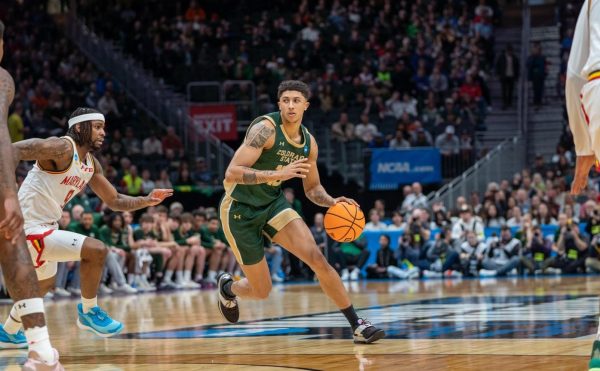Logging sports: A look at one of CSU’s oldest club sports
Collegian | Tri Duong
Karson Wilson, travel and safety advisor of Colorado State University logging sports team, discusses safety measures at the equipment storage at the CSU METEC laboratory Feb. 22.
Natalie Deveraux
February 23, 2023
Unbeknownst to most, Colorado State University has a logging sports team. Practicing from midafternoon to sundown, the logging sports team works on anything from wood chopping to log rolling.
While the logging sports team may perform mundane tasks like wood chopping, they definitely have some variety in their workouts. They use chainsaws to separate large wooden logs into smaller chunks at incredible speeds. They also stand on smaller firewood-sized pieces and chop between their legs to separate the log into two pieces.
“We’re more than a team. We’re a family.” –Mikaela Lippon and Karson Wilson, CSU logging sports team members
Logging sports, or lumberjacking, have been popular in North America for centuries. Because of their popularity, the United States frequently hosts collegiate logging competitions.
“We’re more than a team,” Mikaela Lippon and Karson Wilson said simultaneously about CSU’s logging culture. “We’re a family.”
Competitions between lumberjacks began in the 1920s in the United States as a way to engage in friendly competition with fellow lumberjacks. It then progressed to formal competitions and expanded into the collegiate atmosphere.
The CSU logging sports team was founded in 1983. Logging sports safety was still rudimentary. The fundamentals of the sport have continued on despite changes in history.
Take log rolling for example. While the fundamentals have remained the same, some safety advances have been made. Rather than rolling on an actual log like lumberjacks did in the earlier days of the sport, modern lumberjacks use a foam log filled with water to aid in balance. For less experienced lumberjacks, paddles are added on the ends of the foam log to help with managing the speed of the rolling.
Chainsawing has also been added as a logging sport, with safety precautions due to the danger of the machine. CSU’s logging sports team recognizes the dangers of the sport and prioritizes safety.
“We have a progression that people have to go through before they can reach the certain chopping because they are so dangerous,” Wilson said. Wilson is the travel and safety officer, and it’s his job to make sure everyone is staying safe in the ax yard.
Despite some changes to the sport as technology has advanced, some aspects have remained the same. Crosscut sawing, for example, has not changed much. Crosscut sawing is when two lumberjacks have one long saw and attempt to saw a log in half as quickly as possible. It requires intense teamwork and communication to complete the challenge. Notably, the team refuses to use the crosscut saw in any wet weather to prevent rust on their equipment.
“After our Friday practices, we always try and go get dinner with each other, and then we head to birling practice after that, which is just log rolling,” Wilson said.
View this post on Instagram
“So this sport, other than, like, chainsawing events, tries to stick to a lot of old lumberjack disciplines,” Wilson said.
In fact, tradition is a huge part of logging sports, with the majority of the categories sticking to the original methods of implementation from the 1900s.
CSU’s logging sports team has a full schedule of competition with the All Western Forestry Conclave coming up in April. The team is heading to Oregon State University to compete against around 20 other teams, and they’re sending around 25 of their athletes to compete.
Reach Emma Askren at sports@collegian.com or on Twitter @emma_askren.






